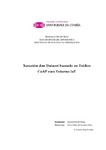Xeración dun Dataset baseado en Tráfico CoAP nun Entorno IoT

Use this link to cite
http://hdl.handle.net/2183/26187
Except where otherwise noted, this item's license is described as Atribución-NoComercial-SinDerivadas 4.0 España
Collections
Metadata
Show full item recordTitle
Xeración dun Dataset baseado en Tráfico CoAP nun Entorno IoTAuthor(s)
Directors
Carneiro Díaz, Víctor ManuelDate
2020Center/Dept./Entity
Enxeñaría informática, Grao enDescription
Traballo fin de grao (UDC.FIC). Enxeñaría informática. Curso 2019/2020Abstract
[Resumo]
A IoT (Internet of Things) está cada vez máis presente no mundo. Ben sexa na nosa casa ou en
procesos industriais, esta tecnoloxía aglutina unha gran cantidade de dispositivos que intercambian
un volume de datos considerable; e que debemos protexer contra ameazas externas.
Neste caso, unha monitorización manual do tráfico non é viable, será necesario expor outros
mecanismos máis automáticos para poder levar a cabo esta tarefa de forma máis efectiva e
eficiente. Para automatizar o proceso de análise e detección de ameazas en fluxos de datos de
grande magnitude é posible usar a IA (Intelixencia Artificial), proporcionándolle os conxuntos
de datos necesarios para que leve a cabo a aprendizaxe máquina; e desa forma sexa capaz
de detectar, e incluso paliar, ditas anomalías. Neste proxecto, crearemos un conxunto de datos
(DATASET) anotado de tráfico do protocolo CoAP (Constrained Application Protocol),
utilizando software para a creación de paquetería de rede. Este protocolo, grazas á súa simplicidade
e baixa sobrecarga, pode ser utilizado en dispositivos cun hardware mínimo; coma
por exemplo os sensores dunha rede IoT. O que faremos neste traballo será, primeiramente,
un estudo sobre as características do protocolo CoAP, para entender o seu funcionamento.
Logo, unha vez escollidas as ferramentas a usar, deseñaremos unha implantación do entorno
a virtualizar, e unha programación das mensaxes CoAP que se enviarán e recibirán entre
as máquinas. Poremos a proba dito deseño e, unha vez estea funcionando correctamente,
alteraremos a paquetería resultante empregando distintos tipos de ataques a redes IoT. Para
rematar, realizaremos unha captura de tráfico final incluíndo todos os comportamentos, tanto
normais como anómalos; e da que obteremos as conclusións oportunas. [Abstract]
The IoT (Internet of Things) is more and more present in the world. Whether in our
home or in industrial processes, this technology brings together a large number of devices
that exchanges a considerable volume of data, and we must protect them against external
threats. In this case, manual traffic monitoring is not possible, it will be necessary to find
automatic mechanisms to carry out this task more effectively and efficiently. To automate the
process of analysis and detection of threats in large data flows, it is possible to use AI (Artificial
Intelligence), providing it with the necessary data to execute the machine learning, and in
this way be able to detect and even mitigate said anomalies. In this project, we will create an
annotated Dataset of CoAP (Constrained Application Protocol) protocol traffic, using software
for creating network packets. This protocol, thanks to its simplicity and low overhead, can be
used on devices with minimal hardware; such as the sensors of an IoT network. In this work,
firstly, we will make a study of the characteristics of the CoAP protocol, to understand its
operation. Then, once we have chosen the tools to use, we will design an implementation of
the environment to be virtualized and a programming of the CoAP messages that will be sent
and received between the machines. We will test this design and, once it is working correctly,
we will alter the resulting packets using different types of attacks on IoT networks. To finish,
we will make a final traffic capture including all behaviors, both normal and altered, and from
which we will obtain the appropriate conclusions.
Keywords
Protocolos IoT
Scapy
Ataques IoT
Ettercap
IoT
CoAP
Sensor
IoT protocols
IoT attacks
Scapy
Ataques IoT
Ettercap
IoT
CoAP
Sensor
IoT protocols
IoT attacks
Rights
Atribución-NoComercial-SinDerivadas 4.0 España






